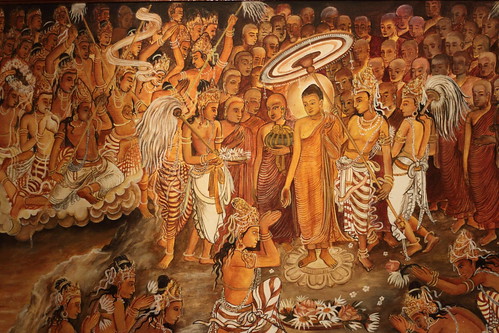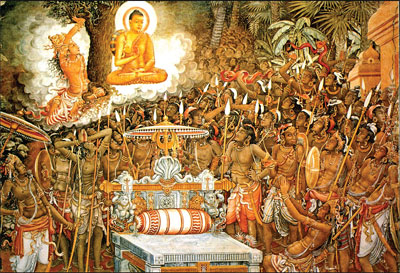Murals par excellence
The chronicles, Dipavamsa and Mahavamsa, record in detail the story of the Buddha's visit to Kelaniya on the eighth year after his enlightenment, on the invitation of the Naga King Maniakkhika. The jewelled throne, on which the Buddha sat while preaching, is said to have been enshrined in the original stupa of the Kelaniya temple.
The earliest historical records note that it was during the 3rd century BC, that the city of Kelaniya was built along with its temple. The original paintings on the shrine walls have been added during the reign of King Voharikatissa (214 - 236 AD). In 1213, an invasion from South India led by Kalinga-Maga, resulted in the destruction of many of the shrines and temples in the island including the Kelaniya temple.
However, King Vijayabahu III rebuilt almost all the temples, and the Kelaniya temple was returned to its former glory. Later, King Parakramabahu II and Parakramabahu VI both helped in further restoration.

The temple was destroyed once again in the 16th century when the Portuguese conquered Sri Lanka, and again it was rebuilt in 1767 by the King of Kandy, Kirthi Sri Rajasinghe.
In this restoration, Kandyan style panoramic paintings were made to adorn the walls, their themes drawn from the Jataka tales and the early life of the Buddha and 'solosmas thana' or 16 sacred shrines in the island. There are also paintings of the planetary gods of the 'Navagrahyo' and zodiac signs.
The temple received further attention in 1888 by Helena Wijewardena who, saddened by the derelict state of the temple buildings, commissioned the famous temple artist Solius Mendis to restore the interiors of the buildings. For more than 20 years, Mendis painted frescoes depicting events in the life of the Buddha and scenes from Buddhist history in Sri Lanka. He also added geometric ceiling paintings to the temple hall.
New Murals

The new paintings are without comparison. Here it's easy to lose track of time admiring the many paintings that tell us the stories of the life of the Buddha and historical Buddhist tales.
From ancient times the tradition has been to paint the walls of temples with portrayals of the Jataka stories. But Kelani Vihara has made a welcome departure from this custom in its new paintings. Instead it has infused variety into the murals by introducing spectrums depicting an array of historical scenes, connected with the birth, rise and progress of Buddhism in Sri Lanka.
Paintings depict King Devanampiyatissa presenting the Mahamegha Park to Arahant Mahinda. Here the King himself is seen marking the boundaries with a silver plough drawn by two elephants and other depiction of Buddhagosha committing the Tripitaka into books at Aluwihare.
This was the first time in history the teaching of the Buddha was set down in writing. Other significant scenes are Buddhagosa's presentation of the Visuddhimagga to the Sangharaja of Maha Vihara at Anuradhapura; King Kirthi Sri conferring the title of Sangharaja to Weliwita Saranankara Maha Thera by presenting him the ivory fan as the emblem of office, the bringing of the Bo-tree by Theri Sangamitta, and the Tooth Relic by Prince Danta and Princess Hemamala. Sinhala designs and patterns run on the pillars. Carved garlands of flowers finely executed in sculptural work curtain off the inner chamber.
The paintings in the outer chamber are breathtaking. They record important events in the history of Buddhism in Sri Lanka and the history of Kelaniya.
The paintings in the upper strip of panels portray the Buddha's three visits to Sri Lanka.
In the lower strip are frescoes depicting the events that led to the killing of the Maha Thera of Kelaniya and the consequent floods and the sacrifice of Princess Viharamaha Devi during the reign of Kelanitissa.

The other notable murals are those showing the institution of Theravada tradition of ordination on the Burmese monks and the looting and destruction caused to Kelani Vihara by Magha in early 13th century and by the Portuguese in the late 16th century.
Solias Mendis
It is said that stone masons from India and gilders from Myanmar joined the local artisans in the restoration process. Their handiwork can be seen in the rows of sculptured swans, dwarfs and elephants on the outside of the temple, and above them the Hindu deities.

And talking of Kelani Temple Murals, undoubtedly Solias Mendis comes to anyone's mind. He was acknowledged to be in modern times the 'The maestro incomparable.' It is said that, he was a genius inspired by the Hindu Goddess Saraswathie, the venerated icon of Art.
When he began his work, he was determined to abandon the vivid shades that had been in vogue.
His paintings are considered to be among the best examples of the fusion of Indian traditions with the techniques of European academic art.) Mendis gave much attention to detail of facial expression. Even the wrinkles seen on the forehead made the faces look real.
These inspired creations were clothed in a mixture of soft shades, giving flashes of a little orange with a tinge of lemon and red where necessary, to provide life and contrast as well. It is said that he made himself the paint from boiling an unorthodox concoction of herbs and roots and bark of trees found in certain parts of the island. He had for its base white clay, often moistened. He also added certain ingredients to act as preservatives of colour.
His painting of buildings, costumes and furniture, appear to be authentic and indigenous.
He stood on scaffoldings for twenty years to paint all that we see. It was left to the Russian born, Karl Kassman to complete the paintings in the Centre room with a backdrop of the Himalayas, to give an impression that the Buddha was looking down with compassion, on humanity from a great height.
There's an age-old saying which says "if you worship once at the Kelaniya temple all the sins of your lifetime would be washed away." It might not be that easy, but certainly, there is a serene and sanctity about the place that could wash away at least some of the most grievous hurts and sins of one's past.
No comments:
Post a Comment